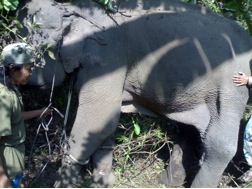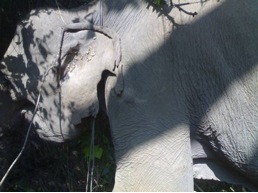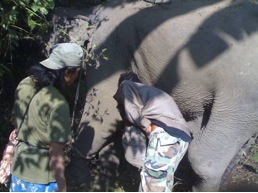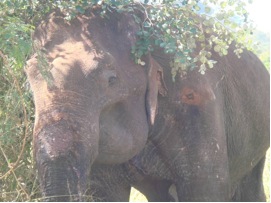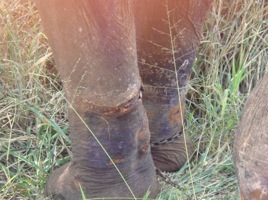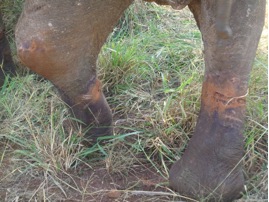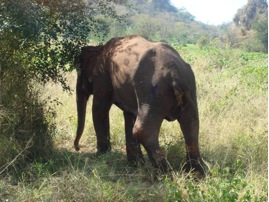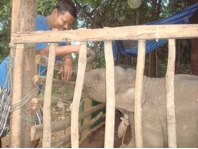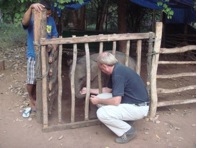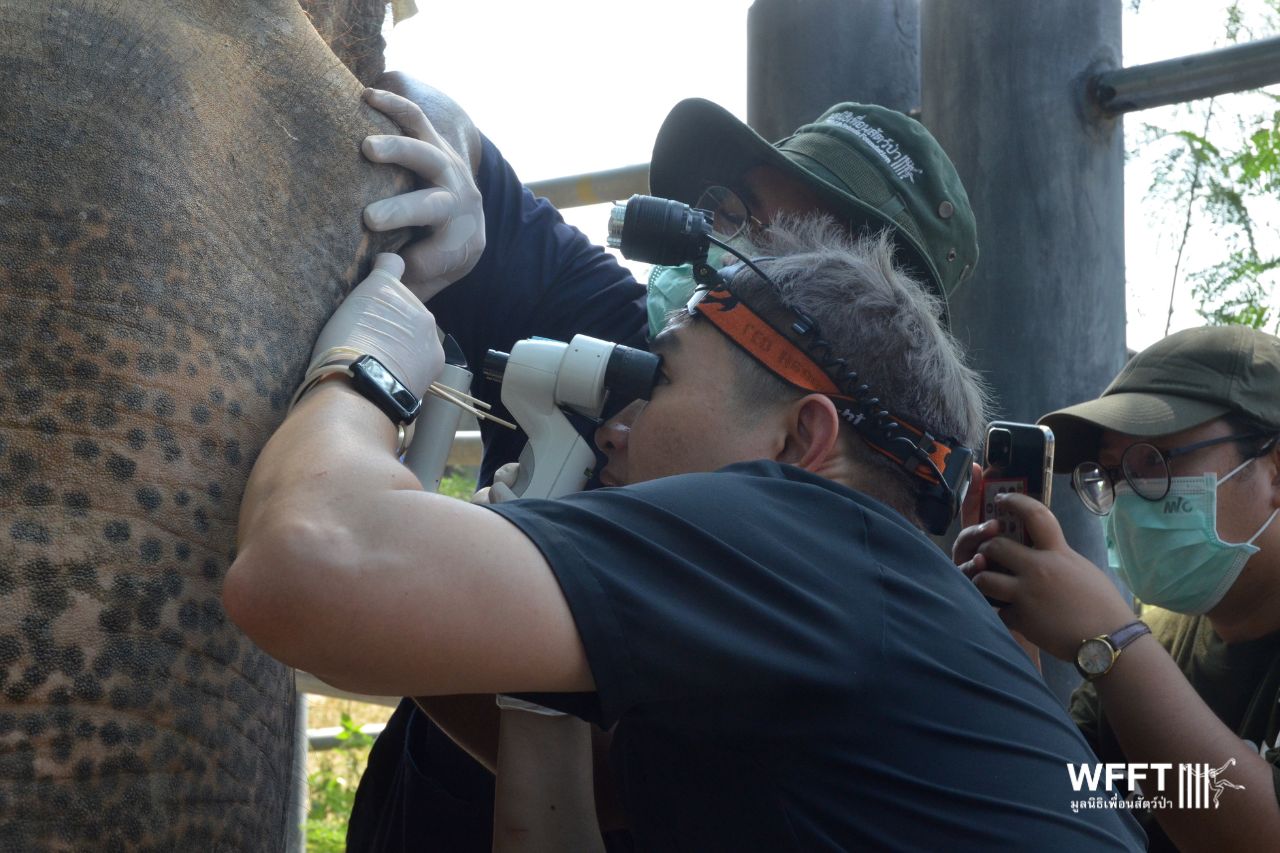Celebrating a whole year of Nam Chok. Still wearing her riding saddle on the day she was rescued, Nam Chok has now spent 365 days free of chains.
Burma – Thailand elephant laundering (part 1)
Burma and Thailand elephant laundering
In a series of stories about the illegal elephant trade in Thailand and the cover ups by some authorities and in particular the head of one specific department Edwin Wiek will in the months coming up to the CITES conference in Bangkok (March 2013) publish investigative reports on the WFFT website. WFFT has been severely attacked this year and is still being attacked an harassed at this moment for helping wild animals, while even after several largely publicized raid on elephant camps and traders still not one case has been brought to justice. From January 2012 to date hundreds of elephants were found illegally possessed at various locations, with severe punishments, confiscations and legal procedures promised. Nothing happened at all however. We are trying to show the truth and the large scale of this ugly trade;
January 8, 2009
by Edwin Wiek
W.F.F.T. Founder
W.F.I. Secretary-general
Kanchanaburi, Thailand – An adult female elephant being transported from the Thai-Burma border was stopped by livestock department officials in Sai Yok district on the 23rd of December 2008 at a routine check. The elephant was found to be in bad medical condition with wounds all over its body and weak due to various infections and mal-nutrition. Ownership documents for the captive elephant were handed over to the officials at the check-point and no wrong-doing was found, however the livestock inspector at duty ordered the owner to take the elephant to the veterinary hospital of Mahidol University at the Sai Yok campus in Kanchanaburi, close by, so veterinarians of the faculty could treat the wounds, infections and have the elephant regain strength.
At the Mahidol livestock and wildlife hospital, the elephant was immediately treated for its injuries that were found all over its body. Veterinarians and staff however found that the elephant did not behave as expected from a captive elephant. The elephant was very tense and was urinating continuously when approached by people and did not know whether or how to eat bananas, apples and pine-apples. The origin of the wounds were also a mystery to some, however suspicion was rising that this female elephant of approximately 17-18 years old underwent “Phajaan” or the breaking of the spirit of elephants to teach them to obey people and allow them to ride the elephants and/or perform tricks. The owner of the elephant (Mr. Boontham Sala-ngam) however was able to show an ownership document for the elephant with a detailed description of the elephant’s body describing the missing part of its left ear, and most major injuries to its body. Stranger even more was the fact that this document was issued by the “palad Amphoe” of Sai Yok only one day before this date (December 22nd) , although the elephant was clearly close to twenty years old, i.e. an adult. Ownership documents are normally issued for baby elephants up to an age of 9 years old, and must be accompanied by their mothers as a form of proof that they were born in captivity. In this case the issuing official did not ask for any proof where the animal had come from and only saw a purchase contract, where Mr. Boontham bought the elephant from a certain Mr. Sompong (without last name). He claimed to have bought the elephant out of compassion for 400,000 baht.
This picture was made on the 8th of December 2008, showing two men checking on the elephant. Metal cables around the neck and left ear are clearly visible. The front legs are strapped together with thick ropes. Injuries on all four legs are clearly visible. Picture made by WFFT investigator. Location Thai-Burma border near Sanghklaburi.
On this picture we can clearly see the metal cables that were used to restrain the elephant during its “training session” Picture made by WFFT investigator. Location Thai-Burma border near Sanghklaburi.
This picture was made on the 8th of December 2008, on this picture we can see two men with the elephant and the man on the right is suspected to be Mr. Boontham.
Picture made by WFFT investigator. Location Thai-Burma border near Sanghklaburi.
On January 7th, 2009, Edwin Wiek and Janseang Sangnanork of the WFFT visited the elephant at the Mahidol campus, by now called “Kanchana” by its owner, together with Dr. Surapol Duangkae, one of Thailand’s environmentalists, to find out more about the current medical status of the elephant, its origin and its future.
Report January 2009 by WFFT team:
WFFT would like to highlight three main concerns about this case:
1. Current state of elephant care:
During the above-mentioned visit, we found that the elephant is slowly recovering from its many injuries and will need a lot more medical care for the next 30 days at least. The vets at Mahidol are giving adequate daily care. Beside the medical attention, the elephant care needs improvement; the feeding only once a day by the owner and the lack of drinking water at the location where the elephant is being kept are a major concern.
We urge the livestock department to step in with means to care for this elephant or accept help from a third party, as it is not the work of the veterinarians to do this.
2. Origin of the elephant:
Secondly, after talking with the director of the hospital Dr. Chowalit Nakthong, the vets and the owner, Mr. Boontham Sala-ngam, we strongly believe that this elephant is a wild caught elephant and not as earlier claimed captive- bred. The origin of the elephant is still a mystery to most, while Mr. Boontham claims he bought it from a certain Mr. Sompong, he is not able to show the last name of Mr. Sompong or his whereabouts, nor can he or is he willing to point out from which location he obtained the elephant. The large amount of serious injuries on the body of the elephant give more reason to suspicion; why is an adult captive elephant to undergo the spirit breaking ritual? This is usually only done to wild caught elephants or very young elephants.
3. Validity of documentation:
Furthermore why was an ownership document issued by the Kanchanaburi District officials for an adult elephant without any legal documents, official ownership documents or being accompanied by the mother of this particular elephant? The owner of the elephant claimed that there were many more elephants for sale in several villages and said that a dozen of elephant owners from Surin province showed interest in obtaining these elephants as they visited several of these elephants in these villages. He furthermore stated that he knew his elephant was probably illegally obtained, but said he spend too much money to let go of the animal.
Picture made at Mahidol campus on Jan 7th, 2009
A very large injury on the top of the trunk, probably caused by the elephant being restrained in to a small area of wood or metal.
Wild animals in general repeatedly swing their head against a fence when captured at first.
Picture made at Mahidol campus on Jan 7th, 2009
Front legs of the elephant show several deep cuts and injury, caused by the restraining of both legs and the binding together.
Picture made at Mahidol campus on Jan 7th, 2009
Both hind legs are severe injured. On both legs we can find deep cuts from restraining ropes and metal wire. The left leg has permanent injury at the knee.
This elephant will probably never walk normal again.
Picture made at Mahidol on Jan 7th, 2009
This is how the elephant is standing in the shade. The overall health of the elephants is still of great concern.
Besides the above case of “Kanchana” at least two more elephants have been found to have come from the wild in the recent months.
Case 1: – Sai Yok:
One baby elephant (pictures 8 and 9) of less than a hundred kilogrammes, estimated at 5 months old, was found only last month (December 4th) with people in the same district of Sai Yok. They claimed that the baby elephant was found alone in the jungle and they suspected it to have been rejected by its mother. This baby elephant was offered for sale. The story told by the people that had the baby elephant in possession seems highly unlikely; the elephant is currently at the Wildlife Breeding Center “Kao Prathapchang” of the Department of National Parks, Plants and Wildlife (DNP) after having been confiscated. (Update 2012: This baby elephant died at the Kao Phratapchang wildlife breeding centre of the DNP a few months later after a staff member let the elephant calf walk close to the tiger enclosures, resulting in a fatal attack by one of the tigers on the elephant, surgery at Mahidol University could not save the poor elephant baby)
Case 2 – Hua-Hin:
Another baby elephant was found at an elephant camp in Hua-hin (Elephant Village). This baby was taken out of the wild in Pala-u, a part of the Kaengkrachan National Park near Hua-hin, and was being trained into submission at the camp. This confiscated elephant too is now being cared for at “Kao Prathapchang” while the legal case is still not ended. Update 2012, no legal case was ever pursued….
Conclusion
For many years we have received information that in many Thai border provinces with Burma ethnic groups as well as Thais capture wild elephants and in particular very young ones. These elephants are poached from within Burma as well within Thailand, and this is a very lucrative business. The main objective of this poaching is to sell these elephants to elephant camps and so called “Nai Toon”; people that invest large sums of money in elephants for the tourism trade and the street begging. In many cases these baby elephants are being matched up with older females from captivity to bond in these provinces before they are taken out to Surin province or to elephant camps to perform for tourists. Some end up as begging elephants on the streets of the larger cities of Thailand, such as Bangkok. Once bonded with a female the owner will claim the calf belongs to the (foster) mother and apply for an ownership document that way as “captive bred”, no DNA is taken or any further evidence required, an easy way to “launder” elephants from the wild into captivity. We estimate that close to a hundred elephants a year are being laundered this way in to the captive population within Thailand. (Figures of 2009, WFFT)
Facts
Lucrative business;
A young female elephant with documents can easily be sold for 800,000 to 1,000,000 Baht. A poacher will probably get less than 100,000 baht.
Pajang or Phajaan;
This ritual still takes place and is basically the torturing of elephants into submission. The ritual can take from 3 to 7 days, where the elephant (usually around 5 to 8 years old) is being beaten and even burned while confined to a very small area until its spirit is broken. Although one long-term elephant conservationist in Lampang province recently denied the existence of these torture training sessions, there is recent photographic and video evidence to sustain claims that it is still happening in 2012…
Law enforcement:
Kanchana’s “owner” was never charged with illegally importing a wild elephant into Thailand. Kanchana was found a few pregnant on second checks, probably the main reason why she was illegally traded. Although Kanchana was very sick and weak she did give birth more than a year later. She never recovered from her injuries and was stressed as she was continuously chained up, without space to move around. Kanchana and her baby died both in vain not long after each-other.
The illegal trade and “laundering” of wild elephants still continues to date. WFFT will continue to investigate and publish their finding to try to put an end to this.

